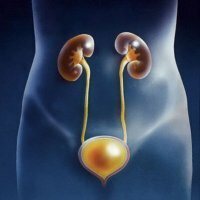Pyelonephritis: symptoms, diagnosis, treatment

In women, anatomical features of the structure of the urinary system are often the cause of the development of infectious inflammatory processes of the kidneys( pyelonephritis) and the bladder( cystitis).As a rule, in women, the urethra, which connects the bladder to the outside world, is straight and very short, so that microbes on the external genitalia on the surface of the skin of the rectum can easily penetrate into the bladder.
In children, the development of inflammatory processes in the urinary system causes an increased vesicoureteral reflux( this is where the retrograde urine returns to the ureter from the bladder).
In elderly people, as well as in whom weak immunity, pyelonephritis usually proceeds heavily. The development of pyelonephritis in pregnant women can lead to complications of a different nature.
Risk Factors
During pregnancy, the risk of pyelonephritis is increased in women. In men, the cause of pyelonephritis can be prostatic disease, for example, hyperplasia( prostatic diseases, usually develop after fifty years)
Often the cause of pyelonephritis are untreated infections of the genitourinary system, diabetes mellitus, disorders of the nervous regulation of the bladder, the presence of kidney stones and calyces-half system, congenital defects of the urinary system, because of which urine outflow, vesicoureteral reflex, and bladder tumors are disturbed.
The presence of infections of the urinary tract, including pyelonephritis in pregnant women is considered a risk factor, increasing the likelihood of premature birth. If the infection is not "eliminated" from the kidney and urinary system, then chronic pyelonephritis will develop. In addition, congenital defects of the urinary system and urolithiasis predispose to the development of chronic pyelonephritis.
Pyelonephritis: symptoms
Pyelonephritis often shows itself unilateral pain below the edge of the costal arch along the side of the back. Sometimes the pain is observed in the lower part of the abdomen and is given to the groin area. Often the pain is accompanied by fever, nausea, vomiting, chills. Urine becomes turbid( sometimes with the presence of blood) and has a sharp fetid odor. There may also be painful, frequent urination.
Pyelonephritis: diagnosis
To diagnose pyelonephritis, urine, blood, ultrasound of the kidney and bladder, X-ray examinations are done. With acute pyelonephritis, diagnosis is not difficult.
Pyelonephritis: treatment of
For the treatment of pyelonephritis, antibiotics are used that are prescribed empirically( based on current recommendations), and are guided by the sensitivity data of the microorganism to antibiotics( the results are obtained when urine is sown).For empirical purposes, antibiotics of a wide spectrum of action are used, which, in uncomplicated pyelonephritis, are administered internally. Typically, the course of treatment is at least 14 days, even in those cases when the symptoms decrease or disappear on 3-4 days of treatment.
Antibacterial drugs used for the empirical treatment of pyelonephritis and other bacterial infections of the urinary system are: a combination of trimethoprim with sulfamethoxazole( Biseptol), levofloxacin, fluoroquinolones ciprofloxacin. If the patient is allergic to these drugs, or the bacteria are not sensitive to these drugs, then other antibacterial drugs are prescribed. Upon completion of the treatment, it is necessary to make a control urine test to determine if the therapy was effective. If from the analysis of urine disappeared proteins, bacteria, normalized the number of white blood cells, then we can assume that the treatment was effective.
If pyelonephritis is accompanied by high body temperature, chills, repeated vomiting, then such a patient should be hospitalized and treated under the supervision of a doctor, this will help to avoid dehydration. In this case, patients are prescribed intravenous infusions and antibiotics, which are administered intravenously.
Severe body temperature, chills can indicate the generalization of infection( the bacterium enters the bloodstream and spreads throughout the body).
If there is evidence of obstruction of the ureter with calculus, which causes urine to not be released from the kidney, doctors can prescribe surgical manipulation: removal of the calculus with a special device that is inserted through the urethra first into the bladder and then into the ureter.
Upon completion of antibacterial therapy, and after the disappearance of signs of pyelonephritis, additional tests are often prescribed, which allows either to exclude or confirm urolithiasis, structural disorders, signs of blockage.
Additional tests:
- Cystoscopy;
- Intravenous urography( contrast is introduced through the catheter, X-ray is taken after a certain time);
- Ultrasound examination of the kidneys and urinary system.



